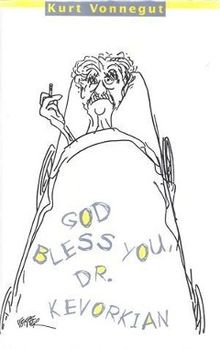Why I love “God Bless You, Dr. Kevorkian”

Photo By: Kurt Vonnegut
“God Bless You, Dr. Kevorkian,” the eighty-page, ambiguously prose book by Kurt Vonnegut, specifically the version with the foreword by Neil Gaiman, depicts an imperfect, funny and gray view of the afterlife. The premise of the book is that Dr. Kevorkian has a device that gives Vonnegut near-death experiences, so he can go to Heaven and interview important people who have died.
The universe of this book has no Hell, and everyone in Heaven is just as they were on Earth. The more hell-worthy people’s interviews are comedic and show how bad people do not often change. The book’s universe also has a radio show called WNYC where each interview is summarized and retold by Vonnegut as what was said in the chapters. Throughout thirty interviews, subjects range from William Shakespeare to Isaac Asimov.
The most important part of this book is how it makes something so complex and raw so simple through few words. It is a talent for someone to be able to make raw emotion and honesty so beautiful. Certain artists, like Vonnegut, have the rare ability to make you feel like your end credits music will sound happy rather than somber. This feeling comes from the optimism that comes from living in the same world as people who can make others feel happier to live. Existential joy is a theme of this story.
He explores how the conclusions drawn about dead people become actual conclusions when a person cannot change or grow any more. Each interview acts as an exploration for Vonnegut to imagine what certain people would have to say about the current world. He explored the moral grayness of man through taking every person’s ideas as objective and portraying them comedically.
The most sentimental part of the concept is that Neil Gaiman, the writer of Coraline, did a foreword that was published after Vonnegut’s death, essentially giving the same kind of interview to him as he “did” to all those other famous people when he was alive. Gaiman talking about Vonnegut the way that Vonnegut spoke about Shakespeare felt like an induction to a hall of fame. Except everyone in a hall of fame shares a hall with many other people. Vonnegut turned out to be the only real person who was aware of these after-death interviews.
This book is short, maybe not giving enough substance necessarily to make someone do a complete 180, but it breaks the surface for one to start living their time well. What tells of the human condition is how art is a more deliberate version of what we all already do; which is being part of a chain. The chain of art is when artists inspire future artists to give people things to grasp onto. The chain of being is how people’s actions perpetually ripple. Gaiman and Vonnegut had an indirect, fictional conversation that created so much closure and respect for the dignity of Vonnegut. This shows how two people can use storytelling to compliment and immortalize each others’ essences and tones, without even realizing it.
The mix of the original book alongside Gaiman’s foreword makes me feel inspired to live and utilize my spot on earth and in my community. Vonnegut has done for me the biggest thing an artist can do; make me feel a newfound zest for life and existential joy. For a book that can be completed in less than two hours, it accomplishes a lot.


